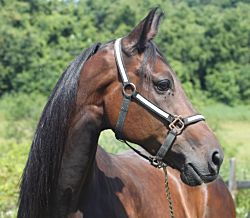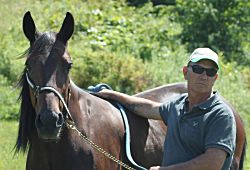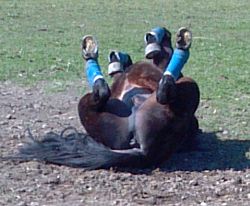War Horses: Stiletto sets sights on a million
February 16, 2012,by Ellen Harvey, Harness Racing Communications
Rarely has one creature labored for another as a horse for a human. From the Crusades to World War I, battles were fought and won on the backs of horses. Frontiers were explored, homes built and communities created from the labor of horses at the will, and for the benefit, of humans. So, too, does the modern day Standardbred labor for their humans. In the heat of summer, through freezing rain, around and around they go. They do our bidding.
Today is the latest installment in our occasional series of snapshots from the lives of the horses who have performed exceptional service to their humans. They are our War Horses.
Freehold, NJ — Just $3,519 short of a million in earnings, every race takes on new significance for 12-year-old trotter Stiletto.
Most of his almost-million came in open class trotting events in Canada, but he’ll race Friday (Feb. 17) at The Meadows at 5-1 odds in race 11, a claiming race set to go at 10:15 p.m. (EST). The gelding, owned by Trudy Hite and trained by her husband Wayne, has slowed a step after 213 starts and 10 seasons of racing, but he is revered in the Hite household.

Stiletto has banked $996,481 in his career.
The Hites operate a small stable at their home in Coal Center, Pa., racing most often at The Meadows. When Wayne Hite heard the vintage trotter, who was second at odds of 42-1 to Peaceful Way in the 2006 Maple Leaf Trot, might be available for sale in the fall of 2010, his curiosity was piqued.
“My son Justin was racing in Delaware and the horse was in Chuck Crissman’s stable,” says Wayne Hite. “He wasn’t broken down, but he was off in the left rear, they weren’t exactly sure what it was. There was a disagreement between Chuck and the owner and they actually ran him through Chick’s Sale. They no-saled him (declined to accept the bid) for $5,500, but they couldn’t iron out their differences.
“My son was there working at the time and he called me because he knows I like old-class horses. I always have. I’d bought several other big earners. I get them on the tail end of their career — I just like them. We were just getting back. Trudy and I took a hiatus from the business for a few years, we went down south and tried to live a horse-free life for a little, couldn’t do it and came back home. Stiletto was our first horse back in the business.
“My son said, ‘You’ve got to get the jump on this horse, he’s all class, he’s a little sore, but the price is right.’ They wanted $7,000 for him. I called and offered them $6,000. It’s a standing offer, 6,000 bucks. They called a few days later and said you could have him, so I bought him, sight unseen.
“When he arrived, our jaws just dropped. He was so beautiful, it was fall and he was dappled and short haired. He was gorgeous, just beautiful. He’s blocky and he’s got a nice rump and a nice build, but he’s not a big horse. We were just so excited. I tried to race him and it appeared he had a suspensory that was bothering him a little bit, but he wasn’t quite right in it.

Stiletto and his trainer, Wayne Hite.
“Here’s a nice old classy horse, I paid $6,000 for him and I had to race him in a $20,000 claimer, one step below the open, because of his past performance lines. They had an 11 claimer, but you’re not allowed to bring in anything to race for less than $10,000. Knowing the old horse the way he is, he went with them and he got a check, first start.
“The second time he pulled up sore and he still tried. I had my veterinarian, Dr. Stanik, look at him and he determined he had two broken splint bones in the left rear. We sent him to Dr. Genovese and he removed two pieces of bone about the size of a miniature golf pencil. Then we rehabbed him and gave him time on our farm. We jogged him, brought him down and he was really good. We raced him and then he tore a front suspensory, but he looked good and sharp.
“We gave him adequate time and this time he was really good and really sharp. I was able then to put him in $8,000 and $6,000 claimers. I even raced him in an amateur trot. Rick Beinhauer drove him and he won, wire-to-wire, just beautiful. It was a nice purse, $10,000 and Rick was thrilled to drive him.”
By 2011, things were looking up for Stiletto and the Hites, with five wins and 23 starts, unless you count the psychological warfare of jogging him.
“He’s perfect to drive. He’s an absolute nut the rest of the time,” says Wayne Hite. “To jog, he’s impossible. He goes two miles every day on the pace free legged. Nice as he can be.
“After two miles, he switches to the trot, turns his head to the left, looks at you with his left eye and says, ‘You better hold on.’ It’s such a routine; I warm him up one lap, because if he switches to the trot, I need to head to the paddock unless I want to put something on him to restrain him.
“He’s the gentlest horse you could ever imagine in the barn. He’s a kid’s horse; he’s a riding horse and kids can ride him. He arrived broken to ride. He’s perfect for that. Once you see the left eye, you’ve got to take a hold of this horse. He does give you a warning, he gives you the left eyeball and here it comes.

Trudy Hite photos
Stiletto enjoys his time outdoors.
“He does have one other quirk, he’s the kind of horse that doesn’t like to come in from outside. We like to bring our horses in every night and he’s got a real problem with that. He makes me chase him every time. We have this ceremony we go through. He just stands in the far end of the paddock until I get near him and then he goes full speed to the gate and then he stands there. We go back and forth like that. I have to jump and jive to catch him, a good 10 to 15 minutes every time.”
While Stiletto won’t get to a million even with a win this week, he is expected to get there soon and the Hites are thinking ahead to that day.
“We want to start a youth ministry and teach kids about the industry from a Godly perspective, that’s what we are about. With some help from the Christian Harness Horsemen’s Association we hope to develop a program. We’re looking to use him for that — not to jog, mind you,” Hite laughs. “He can be trusted, you can put a baby on him. You just can’t send a kid out to jog him.”
Earlier attempts at retirement did not sit well with Stiletto, says Trudy Hite.
“We tried to retire him after the splint bone removal. We took him from the farm to the track to get him shod. He went from head down in the back of the stall, picking at his grain, to head up and rearing in his stall because he was getting shod and he thought he was racing again.
“That’s how we knew he wasn’t done; he was telling us that he wanted to race. We have had horses younger than that that didn’t want to race and they make it easy. You don’t have to wonder. He was strutting through the barn and talking to other horses. We knew he wanted to race, but it’s tough racing here. I’d love to see him at a track in Maine, but I don’t trust him with anyone else.”
Trudy Hite is thinking this might be a good summer for a wise horse to teach a young man about racing.
“He’s perfect on a small track, we were even talking about maybe letting my 16-year-old son Carter drive him at the fairs,” said Mrs. Hite. “I thought it might be a nice way to give him a purpose because the fair racing isn’t that hard on them. He’s in the process of getting his trainer license, and it would be a way he can get his feet wet and Stiletto could still have a purpose.”
Editor’s Note: Do you know of a notable horse now in their sunset years? We’d like to hear about horses at least 20 years old who either made 200 or more career starts or earned $500,000 or more in purses. Tell Ellen Harvey about it at ellen.harvey@ustrotting.com.
